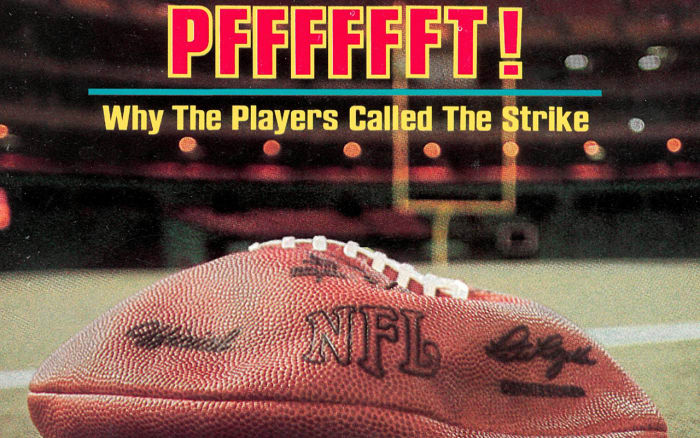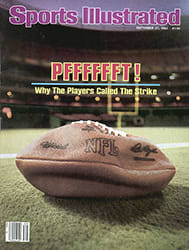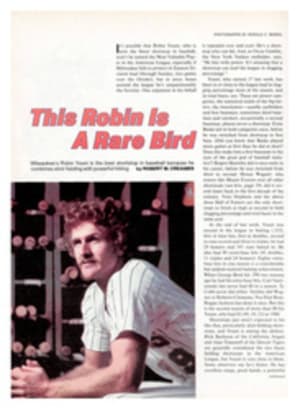And Then The Clock Showed 00:00
At 4:30 Monday afternoon, Ed Garvey, the executive director of the NFLPA, and eight players, six of them from the union's executive committee, entered the Morgan Room on the second floor of Halloran House, a midtown Manhattan hotel. Garvey introduced the players to the assembled media and then turned the microphone over to the president of the union, Gene Upshaw of the Raiders.
"This announcement comes with no pleasure whatsoever," Upshaw began. "At the conclusion of tonight's game between the Giants and Green Bay, all NFL training facilities will be struck. There will be no practices, workouts, or training. No games will be played until management abandons its unlawful course and engages in good-faith bargaining and executes a fair and equitable agreement. We are prepared to withhold our services, however long it takes. We have a solid front. The first game it will affect will be Thursday [Sept. 23]...."
How long will the first regular-season strike in the league's 63 years last? If it isn't settled before Sunday, Sept. 26, it may well continue for a month. According to Upshaw, it will take the owners three weeks to feel the economic pinch. "We've said that we're prepared to stay out one day longer than they are," says Joseph A. (Chip) Yablonski, an NFLPA labor counsel and a union heavyweight in his own right; he led the reform of the United Mine Workers after his father, mother and sister were murdered in 1969.
According to Upshaw, 94% of the players agree with the union's position. But more is at stake than issues. Negotiations with the NFL Management Council, led by its executive director, Jack Donlan, began last February but, essentially, went nowhere. Many union members blame Donlan, who gained a reputation as a tough negotiator when he worked for the now defunct National Airlines. "Shoot-from-the-hip Jack Donlan," says Yablonski. "I would think that the owners would now supplement their bargaining committee with new faces, but they may leave Donlan there because to remove him would be to admit a horrible mistake. Given Donlan's lack of credibility, there could be no handshake deal. Everything will have to be written out."
The players don't intend to set up picket lines, as they did in 1974 when they struck training camps and exhibition games. "I've told them it's like a strike in which 140,000 coal miners in 24 states never show up for work," says Yablonski.
The key issues are:
1) Money. Last Friday, in the final negotiating session before the strike, the union withdrew its demand for a 55% share of the NFL's gross revenues, a demand that Upshaw once declared was "etched in stone." Donlan had flat out rejected a percentage of the gross, be it 55, 40 or 20%, because, he said, it would make the union partners with the owners. So the union asked the league to create a player's compensation fund of $1.6 billion over the next four years, the money comprised of 50% of TV revenues during that period plus other funds. Why did the union change its stance? Pure p.r. As Garvey said, "To all the arguments that a percentage of the gross would make us partners with the owners, we say nonsense. But we thought it wise to shift to the TV revenues, which in essence follows the same idea. It's been a tough sell for most people, the public, that the players should get 55 percent of the gross, but a 50-50 split of the TV revenues seems fair."
In short, the union wants $1.6 billion over four years. On this issue, the two sides don't seem far apart. Donlan says the NFL will give the players the $1.6 billion but over five years. "That's an average of one million dollars a player during the life of the contract," he said. In words that may well memorialize the strike, Garvey retorted, "I am convinced they're offering $1.6 billion about as much as I'm convinced there's a tooth fairy."
2) How the money should be paid. The NFL has offered to pay each player $10,000 for each year since 1977; any player with six or more years in the NFL would get $60,000 in credited service pay, plus another $10,000 when a contract is signed with the union. As far as salaries go, the league prefers the old system, with each team deciding who gets how much. The NFL says that if the teams haven't paid out the $1.6 billion in five years, it will give the remainder to the players to whack up among themselves. The union says no dice. It insists on a wage scale with incentives and performance bonuses. Is this etched in stone? "Absolutely," vows Garvey.
Here's how the union plan would work. Instead of a player negotiating his own contract, he would be paid a set salary based on his years in the NFL. For instance, all players would get the same annual base wage of $127,000 in their third season. Above scale earnings would begin to vary. Also, any player who had made the Pro Bowl would get an extra $6,000 for each time he had played in that game. For example, Pittsburgh Middle Linebacker Jack Lambert, who had spoken out against the union until he attended its Albuquerque convention in March, when this plan was fine-tuned, would get $42,000 tacked onto his base pay because he's played in seven Pro Bowls. Starting this year, a player would have $11,000 added to his base for each future Pro Bowl selection.
Then there are incentive and performance bonuses. Players who start and play every offensive or defensive or special teams down would get an extra $1,750 for each game. Those who play less would earn less, proportionately. The players also would select the 272 top performers for a season based on position, such as the 10 outstanding centers, the 20 best offensive tackles, the 32 best linebackers, the 10 top kickers. Each of the 272 picked would earn an extra $20,625. There would be team performance bonuses calculated on stats in such categories as total rushing yardage, number of sacks per passing attempt, fewest yards penalized, most field goals blocked and so on. The units that rank 1 to 5 in 11 different categories would get $186,000 to divide among the players "in proportion to downs played with that unit or team." Six special team units would divvy up $114,000.
There would be a playoff pool, too. A wild card team that goes on to win the Super Bowl, as Oakland did in 1981, would divide up more than $4 million in toto, or more than $80,000 per man.
Garvey and Upshaw insist on this wage scale bolstered by performance and incentive bonuses.
"That's not a wage scale," snorts Donlan. "It's a minimum." The owners point out that there is nothing to prevent a player from holding out for more money. Moreover, the wage scale is an open invitation to a rival league, such as the new USFL, to bid against the NFL for top rookies and other talent. The players' solution to this problem is a discretionary fund of an additional $500,000, which all teams would maintain to take care of bonus payments. The owners say this is no solution at all.
"The wage scale destroys incentive," says Donlan. "You end up overpaying people on your own team. A starting fourth-year linebacker would get less than an eight-year linebacker who isn't playing regularly. It would increase the salaries of the marginal players, and it doesn't reward the guys who are genuine contributors."
The union contends that the NFL has to go along with the wage scale plan because, as Yablonski says, "We have an exclusive right to represent employees for purposes of wages, benefits and other terms and conditions of employment. Donlan's current position that he won't accept a wage scale and incentives is a refusal to bargain collectively with the union. He's saying we have to waive that right. That's illegal." On Monday the union, which had filed eight unfair-labor-practice charges against NFL ownership—the National Labor Relations Board has already issued rulings in favor of the union on two of them—also charged the Management Council with refusing to bargain on wage scale and incentives before the strike. Proving that unfair labor practices forced the strike could be a bonanza for the players, a nightmare for the owners. The union maintains such a finding by the NLRB would mean 1) that the players would be free to play the All-Star games they've lined up with Ted Turner's superstation and 2) that the owners might even have to pay them for the time they spend on strike. Moreover, the players would be guaranteed their jobs back upon the signing of a new collective bargaining agreement.
Another major issue is the matter of drugs. The union submitted on Friday that "There is no longer a major problem in establishing a joint counseling and drug rehabilitation program." Not so, says Donlan. "The union says no testing of players, we say testing." To which Yablonski counters, "Any kind of blanket testing of players constitutes an invasion of privacy. It presumes guilt."
Several hours before Upshaw's announcement on Monday, Donlan was optimistic that though the strike was a foregone conclusion, the two sides would soon reach an agreement. "The reason I am optimistic," he said, "is that a strike doesn't make any sense to me. We're close in the dollar figure. We just have to figure out how to package it. When they strike, the heat will be on everyone. So the question the players will ask themselves is, 'What are we striking over?' Someone will say, 'Well, we want $1.6 billion.' And then someone else will say, 'Isn't that what they offered us?' And then someone else will say, 'Yes.' And then I think the union's going to get a lot of pressure back."
To which Garvey responded, "I think he's crazy."
Bring on the tooth fairy. Please.
PHOTO
When this meeting chaired by the bespectacled Garvey and Upshaw (striped shirt, opposite) broke up, the strike was on.
PHOTO
To Garvey the issue is as simple as ABC.
PHOTO
To Donlan it isn't money, it's packaging.


